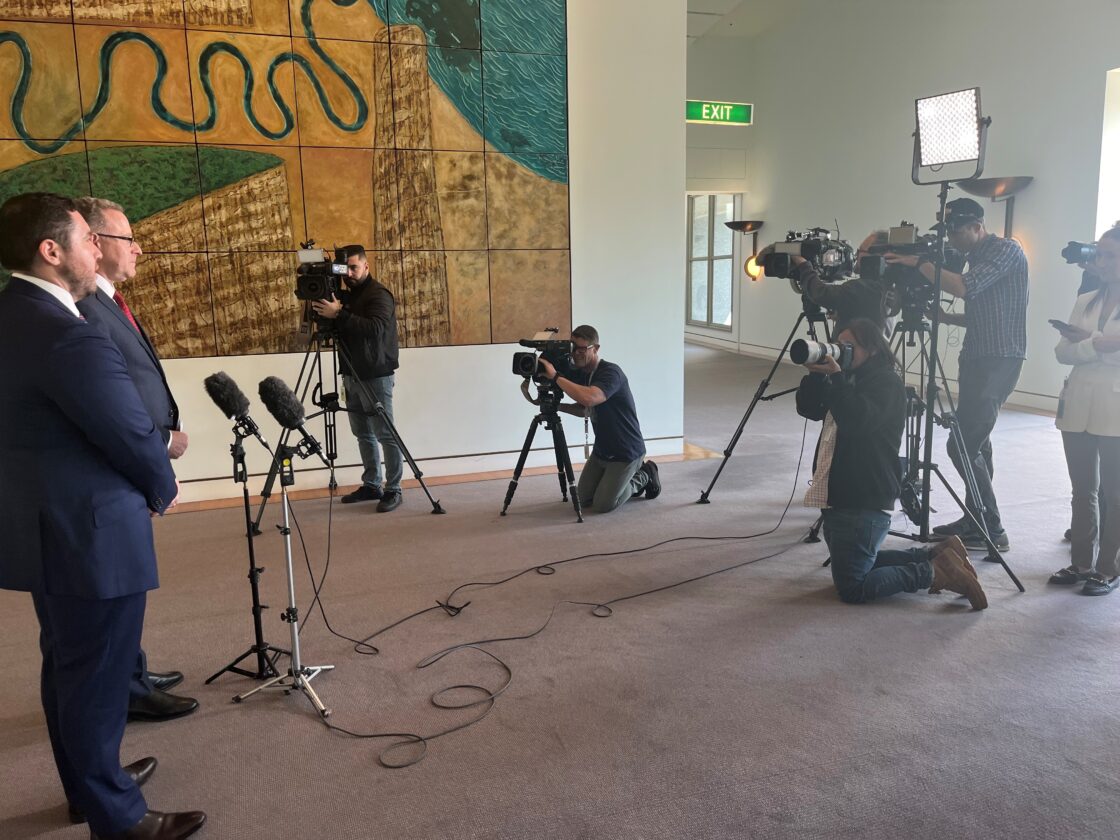Doorstop ACCI Westpac Survey of Industrial Trends
19 Sep 2024
|Transcripts

Event: Andrew McKellar and Westpac’s Pat Bustamante doorstop at Parliament House Canberra
Date: Thursday 19 September 2024
Topics: ACCI Westpac Survey of Industrial Trends, unemployment rate, interest rates and migration
E&OE
Andrew McKellar:
Today we’re speaking about some of the current news on economic conditions and in particular today we’re launching the Westpac ACCI survey of industrial trends for the September quarter, which provides an up-to-date indication of conditions for Australian manufacturing. I think what this survey shows is that the good news is that there are signs of life in the patient. We see that there is a faint and variable pulse for Australian manufacturing. Nonetheless, the patient is certainly alive. This quarter’s survey shows that there’s been improvement, positive measures in terms of output and orders. That’s a good thing. We’re seeing that there is strength and resilience in terms of the labour market indicators and that’s entirely consistent with the data that the ABS has just released in relation to employment. So that’s also positive of more concern though, is the indication that cost pressures remain significant for manufacturers.
So we’re seeing ongoing pressure in terms of input costs. We’re seeing some uplift in selling costs, but there are constraints in the extent to which manufacturers can pass through any of those cost increases that they’re getting. So that’s a constraining factor. The other point that comes out from that is that wages costs continue to amount pressure. So we are continuing to see upward pressure on wages and when you put that together with other data that we’re seeing, that adds up to pressure on profitability as well for manufacturers. And that’s also reflected across other areas of business, small business, medium sized business, continuing to experience pressure there. We don’t expect to hear from the unions or the ACTU anytime soon descriptions of wages gouging, but certainly I think that is an indication of concern for business at this point in time. I’ll bring Pat in at this point to make some brief comments on the detail of the survey and then open it up to questions. So Pat over to you.
Pat Bustamante:
I would add that the other positive signal from the survey is that businesses intend to invest more so investment intention has increased, and we know real income growth is only on the back of higher productivity, so we do see more investment that’s going to lead to higher productivity which is a positive. But also be reflecting as Andrew mentioned, the higher costs when it comes to wages and businesses trying to cut costs essentially by investing and upskilling their capital stock. Besides that, I think Andrew’s covered most of the key points.
Andrew McKellar
Very good. Alright, let’s open it up for some questions
Journalist:
Andrew, are employers cutting back on hours to avoid sacking people at the moment?
Andrew McKellar:
Well, in fact, no they’re not. What the survey shows that in fact overtime hours in the past quarter in manufacturing have picked up. So I think that is a reflection that there are some renewed signs of positivity in the data there. In terms of orders coming through and output, I think employers are probably waiting to see what will happen. If that’s sustained, then I think that could even help explain why we’re seeing some of the positive growth in employment. But the labour market has been incredibly resilient. That’s a great thing. That’s a good thing to see that there are more jobs and that unemployment is not increasing as rapidly as might’ve otherwise been expected.
Journalist:
Given the labour market, there are many people working two or three jobs to stay afloat. There are reports of that as well?
Andrew McKellar:
Look, I think obviously there is an element of that going on that people are seeking to keep their incomes up at a time when the cost of living has been going up. So there is of course some of that going on. The good thing at the moment is I think that there is still demand there for labour and obviously we want to see that sustained for as long as possible.
Journalist:
Just a question for Pat, unemployment has remained steady at 4.2 per cent in August. What do you think this means for a potential interest rate cut?
Pat Bustamante:
So we’ve seen the unemployment rate, I guess fluctuate around the 4.2per cent mark over the last say six months or so. We’ve been seeing a very gradual kind of easing in labour market conditions and really the August rate is consistent with this kind of gradual rate, nothing falling off the cliff. Labour market still remains tight compared to where it was say pre pandemic, but it more in a kind of gradual sense. We have seen a bit of easing when you look at things like underemployment for instance.
Journalist:
So it won’t accelerate any decisions to cut interest rates you think?
Pat Bustamante:
I think this is consistent with the Reserve Bank’s forecast, so they won’t be reading too much into it.
Journalist:
And do you think the Federal Reserve’s decision to cut interest rates will add any pressure onto the RBA here?
Pat Bustamante:
I think the Reserve Bank’s made it clear that they’re looking at domestic cost pressures. I guess secondary orders kind of influencers come globally, but it’s mainly those domestic cost pressures that they’re looking at and whether you can get inflation down sustainably back to target. So I think very, if anything, very marginal impact on the Reserve Bank’s future movements.
Journalist:
And Pat have the cost pressures in the survey from today. What’s the significance of those with the inflation outlook?
Pat Bustamante:
Yeah, so as Andrew said, there are still those cost pressures there and businesses have been unable to pass that on. So there’s a bit of margin compression, but that’s what the reserve base has been concerned about. That’s what the governor’s been talking about. These cost pressures remain, I guess more elevated than they were pre pandemic. And if they remain elevated, well obviously it makes it harder for them to start easing given that these cost pressures have to come down. So it’s kind of consistent with what we’ve been seeing. But they do remain high coming down slowly, but they think they have a bit more to go to, I guess make the Reserve Bank confident that inflation is sustainably heading towards a two to three per cent target.
Journalist:
Why do you think the jobs market is so resilient?
Andrew McKellar:
Look, I mean I think it has been surprisingly resilient. I think the fact that we’ve had just some more recent positive signs in output and orders, obviously businesses don’t want to lay off people unless things really turn south. So I think generally it’s a lagging indicator. I think it’s a positive thing that we should take out of it that employment has been so strong. Interest rates have had a broader impact on demand, but we have areas of the economy which I think are being pushed in a different direction and we know that I think two things are doing that. One is fiscal policy, fiscal expenditure by the states and by the federal government. So one has to look at the composition, how much of that employment growth has been in public sector employment versus private sector employment. And the other thing here, which I think is a bit more of a concern, is this impact of wages growth. And I think those two elements of government policy pushing somewhat against where the Reserve Bank is trying to take the economy with interest rates. So there is a bit of a tension there and I think that tension has to be resolved at some point. Something has to give at some stage,
Journalist:
Andrew interest rates are often seen through the lens of a mortgage holder or a renter, for a small business or for any business what would a rate cut mean to their output, their ability to employ and what they can do long term?
Andrew McKellar:
Look, it can be very important and of course many small businesses, they are debt financed. In many cases people are mortgaging their home to support to provide capital for their small business. So for a small business owner, that’s a big factor. And if we start to see interest rates coming off, honestly, I think that’s going to be the fastest way to take pressure off the cost of living and the fastest way to take some of those cost pressures off business and particularly small business in the near term.
Journalist:
Andrew, can I ask about the migration figures that are out today? Net migration rising again in this last quarter 134,000 I think it was, was the net figure for the first three months of this year. The government wants to bring that level down. They’re set to exceed the target that they put for the last financial year. Is it a good thing that they’re going to exceed that target? What would the implications be if that migration figure was to fall like the government wants it to?
Andrew McKellar:
Well, look, we’ve always said we’ve got to get the right balance in terms of migration. We have a big skills demand still in the economy and I think that’s had kept levels high, but we’ve seen reforms that have been introduced in terms of the temporary skilled programme, we’ve seen pretty stable level in terms of the permanent migration intake. So those policy settings are more or less right. I think what we’re seeing at the moment is still a levelling out coming out after the uptake when the economy opened, there was of course a surge back in migration. I think we’re still seeing that playing out. We would expect that over the course of the next 12 months, there will be a return to more normal levels. So we don’t think there’s a cause to panic on migration. We think that the settings, the policy settings are more or less right at the moment and we’ll see a natural equilibrium being achieved in the next 12 months or so without a panic being undertaken.
Journalist:
These are targets that should be broken in that sense really?
Andrew McKellar:
Well. I think it’s always very difficult to try and set targets around net overseas migration. We think the government should be setting its migration settings around the permanent intake and also what they want to issue in terms of temporary skilled visas, international students, working holiday makers, those sorts of categories. If they get those right and they hit target there, then more or less we should be on track.
Journalist:
Just one more Pat, if I can, with the RBA meeting next week, what sort of posturing would you expect to see from the bank? Do you think the same message repeated or any shift would you expect?
Pat Bustamante:
I would expect it to remain on message, it to remain quite hawkish. As I said, we haven’t … we’ve seen cost pressures start to decelerate, but those still remain high. We’re seeing that in the actual business survey. We’ve seen that in other surveys. So my sense is that they’ll remain, the messaging will remain the same as it was in August.
Andrew McKellar:
Good, thank you. Appreciate it. Thanks everyone.


